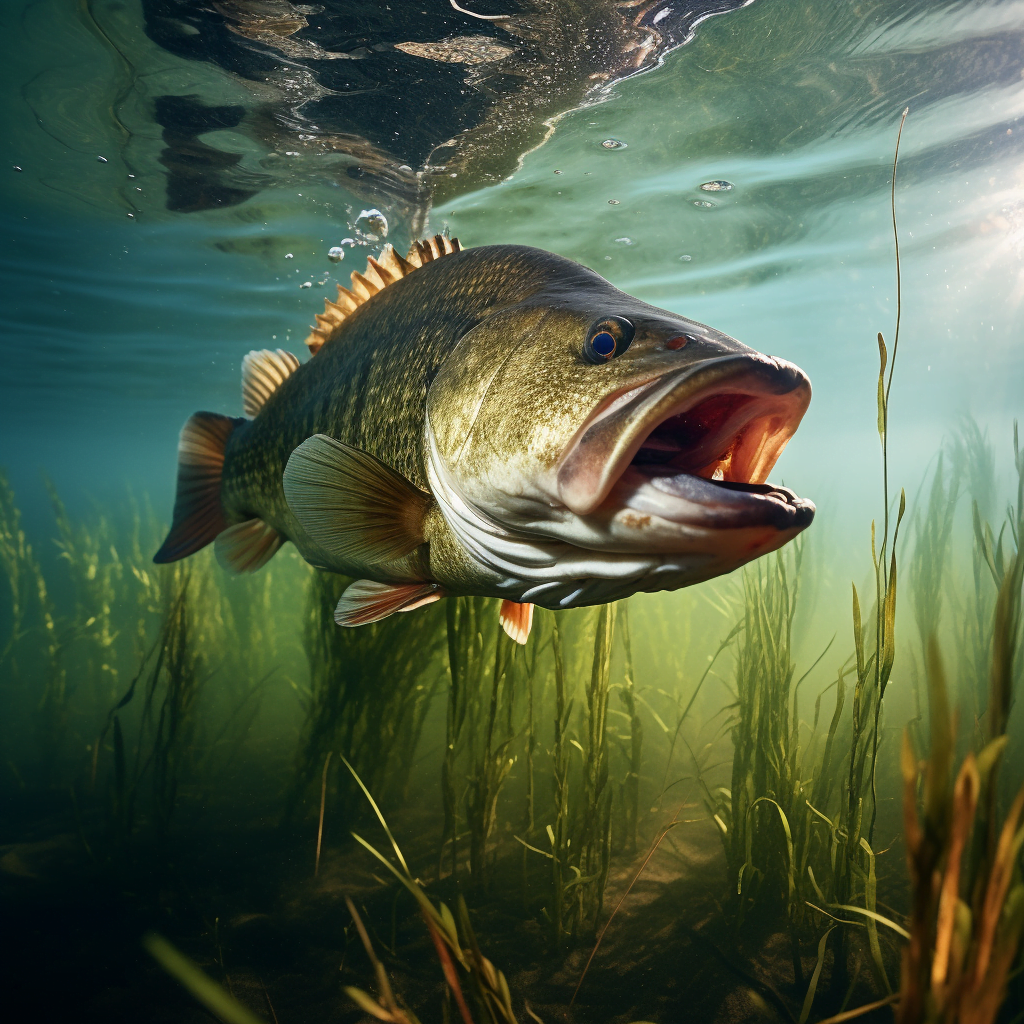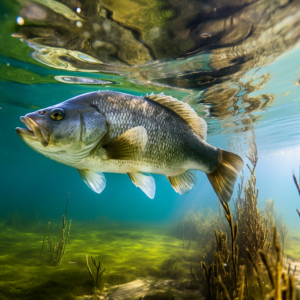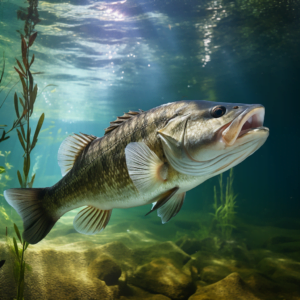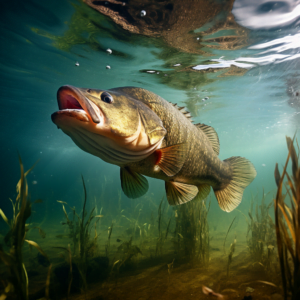Introduction: Are Largemouth Bass Endangered?
The status of the Largemouth Bass species in terms of endangerment has been a topic of concern and debate. This introduction aims to provide a comprehensive overview of the current understanding regarding the endangered status of Largemouth Bass. Through careful examination of scientific research and conservation efforts, this document seeks to shed light on the conservation status of this iconic fish species.

| Key Takeaway | Details |
|---|---|
| Largemouth Bass Introduction | – Status of Largemouth Bass‘ endangerment discussed. |
| – Found primarily in southeastern U.S. and introduced to Maine in late 1800s. | |
| Identification | – Olive-green to greenish-gray body. |
| – Dark lateral band with a darkened blotch at base of rear dorsal fin. | |
| Habitat & Diet | – Inhabit lakes, ponds, reservoirs, slow rivers. |
| – Diet varies with age, from insects to larger prey like fish and small rodents. | |
| Fishing Tips | – Various lures and baits effective. |
| – Best times are early morning and evening during hot summer. | |
| Habitats and Seasonal Patterns | – Move to shallow waters in summer. |
| – Target areas with vegetation. | |
| Interesting Facts | – Males guard nests and fry aggressively. |
| – Can live for over 20 years. World record is 22 lbs 4 oz. | |
| Population Trends | – Introduced to Maine in 1800s. Populations grew in southern and central Maine. |
| Threats | – Overfishing, habitat degradation, climate change, invasive species, pollution. |
| Protection Laws | – Size limits, daily bag limits, closed seasons, habitat protection laws. |
| Maine Fishing Outlook | – Managed differently across regions. Special regulations and closed seasons considered. |
| Conservation Efforts | – Anglers can practice catch-and-release, participate in habitat cleanup, and follow fishing regulations. |
| Conclusion | – Largemouth bass face various threats but careful management can maintain populations. |
Background on Largemouth Bass
The largemouth bass (Micropterus salmoides) is a popular freshwater game fish originating from the southeastern United States that was introduced to Maine waters in the late 1800s. With its large mouth and sweeping size, this ambitious predator has firmly established itself as a prize catch for anglers.
This species is easily identifiable by its upper jaw extending back beyond the rear margin of the eye. They have an olive-green to greenish-gray body fading to a lighter belly. A dark lateral band runs along the middle, with a darkened blotch at the base of the rear dorsal fin. The underside of the jaw is white or pale.
Typically, largemouth bass in Maine range from 12-16 inches in length and weigh between 1-3 pounds. The current state record is 10 lbs 3oz caught in 1955. Exceptionally large specimens can reach up to 7-8 pounds. Generally, bass over 20 inches in length are considered trophy-sized in Maine.
Largemouth bass inhabit lakes, ponds, reservoirs and slower moving rivers and streams throughout the state. They prefer areas rich in cover like submerged woody debris, weed beds, lily pads, and rocks. This provides ambush points to attack prey and shelter from predators. Prime largemouth habitat has abundant vegetation and structure.
These adaptable predators have a varied diet that changes as they grow. Young bass start by feeding on insects, zooplankton, and other invertebrates. As they mature to adulthood, they graduate to larger prey like crayfish, frogs, smaller fish, and even small rodents and birds. Adult bass will consume whatever they can fit in their large mouths.
Fishing Tips for Largemouth Bass
Many types of fishing gear can be effective for catching largemouth bass:
- Lures – spinnerbaits, crankbaits, jerkbaits, topwater poppers, buzzbaits
- Soft plastic baits – worms, creature baits, craws, flukes, grubs
- Live bait – minnows, nightcrawlers, crayfish, hellgrammites
Some best practices and tips for bass fishing include:
- Early morning and evening hours are best during hot summer weather when bass are more active.
- Focus on fishing heavy cover like fallen trees, docks, weedbeds, and lily pads.
- Vary lure retrievals until you determine the preferred speed for the conditions.
- Use stout rods and 10-20 lb test monofilament or fluorocarbon line.
- Set the hook immediately on any strike. Use strong hooksets to get through their bony mouths.
- Bring a variety of lure colors to test different hues.
Habitats and Seasonal Patterns
In warmer summer months, largemouth bass move into shallow waters less than 3 feet deep to feed and spawn. Target areas with plentiful vegetation like milfoil, coontail, and cabbage weeds. Floating docks, deadfall trees, and lilypad edges also hold fish looking for shade or ambush sites.
As water temperatures cool in fall, look for bass to migrate to deeper drop-offs, ledges, and weedlines for feeding. Slow rolling or jigging soft plastic crayfish imitations can entice inactive fall and winter bass. Focus on prime structure spots like sunken islands, points, and creek channel edges during colder months.
Interesting Largemouth Bass Facts
- Nest Protection – Male largemouth bass build saucer-shaped nests each spring in shallow water near protective cover. They fan these nests and aggressively defend them from predators. Largemouth are devoted parents, guarding fertilized eggs and newly hatched fry in the nest until they disperse.
- Longevity – Largemouth bass can live for over 20 years in Maine lakes and ponds. Their growth rates depend on habitat, available food sources, and climate conditions.
- World Records – The current all-tackle world record for largemouth bass is 22 lbs 4 oz caught by George W. Perry in Georgia in 1932. The record has stood for over 80 years.
- Invasive Potential – Largemouth bass are opportunistic feeders. When introduced outside their native range, they can decimate native fish and amphibian populations. Their robust appetite makes them a problematic invasive species if stocked in new ecosystems.
Largemouth Bass Population Trends
Historically, largemouth bass were abundant and widespread throughout their native range in the central and southeastern United States. Increased recreational fishing pressure and habitat loss from shoreline development over time impacted populations in some areas.
Largemouth bass were first introduced to Maine waters in the late 1800s as part of widespread stocking efforts centered around developing recreational fisheries. Populations expanded rapidly as bass proved well suited to habitats across southern and central Maine.
Today, state fisheries agencies actively monitor and manage largemouth bass populations through:
- Stocking programs to supplement natural reproduction
- Imposing size/catch limits and closed seasons during spawning periods
- Habitat enhancement projects and shoreline protection laws
Threats Facing Largemouth Bass
Several factors can negatively impact largemouth bass populations:
- Overfishing – Recreational angling removes too many adult bass before they can reproduce. Minimum size limits allow juvenile bass time to reach maturity.
- Habitat degradation – Dams, shoreline development, sedimentation, pollution, invasive species and climate change all contribute to declining bass fisheries by destroying critical spawning and feeding habitat.
- Climate change – Warming waters impact timing of bass spawning periods. Invasive species and diseases associated with climate change also threaten native aquatic ecosystems.
- Invasive species – Non-native pike, muskie, and pickerel as well as aquatic plants like variable-leaf watermilfoil outcompete and displace native species.
- Pollution – Eutrophication, organic pollution, pesticide/fertilizer runoff, and industrial chemicals can make waters uninhabitable for bass populations.
Largemouth Bass Protection Laws
Most states have regulations in place to protect largemouth bass populations:
- Minimum size limits – typically 12-15 inches depending on the fishery
- Daily bag limits – often 5 bass per day or less
- Closed seasons – spawning periods off limits, usually April – June
- Tackle restrictions – limit destructive gear like gaffs, spearing
- Habitat protection laws – limit shoreline development, minimize sediment runoff
Anglers should always check local fishing regulations before heading out. Proper licensing is mandatory, and failure to follow rules can result in fines or loss of fishing privileges.
Largemouth Bass Fishing Outlook in Maine
The Maine Department of Inland Fisheries and Wildlife manages largemouth bass differently across regions:
Central and Southern Maine
- Valued as a premier sport fish and managed with stocking programs and regulations
Northern Maine
- Not actively managed over concerns about potential impacts on native brook trout and Atlantic salmon
Statewide
- Special regulations on some waters – e.g. catch and release, trophy bass management
- Minimum length limit of 10 inches on most waters
- No closed season – can be fished year-round
Some practices can help maintain bass populations in the regions where they are managed as a sport fishery:
- Habitat protection and enhancement – install fishing reefs, restore vegetation
- Catch-and-release fishing
- Strict enforcement of size and creel limits
- Closed seasons or special regulations during spawning period
But localized concerns persist in some watersheds. Continued proactive management and stewardship efforts are needed to ensure healthy largemouth bass fisheries across their Maine range.

Ways Anglers Can Help Largemouth Bass Conservation
Recreational bass anglers play an important role in conservation:
- Follow all fishing regulations for size/catch limits and closed seasons.
- Practice careful catch-and-release techniques:
- Use barbless hooks
- Minimize handling time
- Release fish in the water when possible
- Don’t hold bass vertically by the jaw
- Participate in habitat cleanup and enhancement volunteer efforts.
- Report any signs of illegal fishing or poaching activities to authorities.
- Support tackle donation programs to responsibly recycle old gear.
- Model ethical angling practices when taking youth fishing.
Conclusion
While not considered globally endangered, largemouth bass do face threats from overfishing, habitat loss, climate change, pollution, and invasive species. Careful management and stewardship efforts are needed across their range to maintain bass populations, especially in northern fisheries like those in Maine.
When introduced outside their native southeastern habitat, largemouth bass can wreak havoc on local species unaccustomed to their voracious appetites. But in waters where they are established as a popular sport fish, anglers and policymakers must continue working together to balance conservation needs with recreational fishing opportunities.




